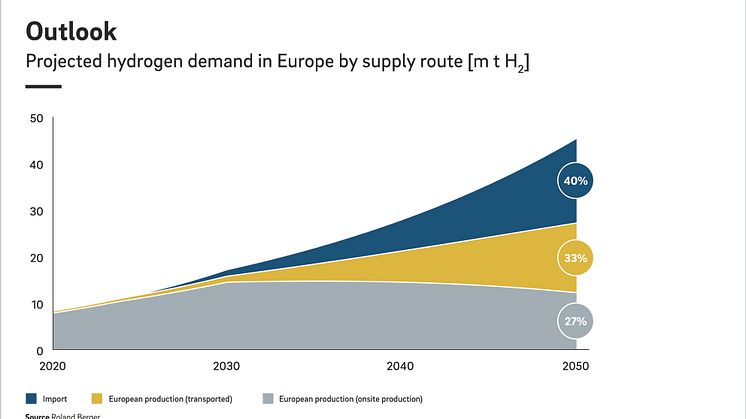
Press release -
Clean hydrogen: efficient transportation solutions will determine commercial success
- Demand for hydrogen in Europe is expected to rise to more than 45 million metric tons by 2050
- Cost-effective transportation of clean hydrogen will become a crucial factor for this energy source
- By 2050, 40 percent of Europe’s hydrogen demand will come from imports
Munich, November 2021: Clean hydrogen is regarded as the energy source of the future and a key element in the energy transition. However, one major factor has been neglected so far: the transportation of clean hydrogen from production facilities, some of which are in remote locations, to the places in industrial agglomeration where it will be consumed. In the study, “Hydrogen transportation: The key to unlocking the clean hydrogen economy,” Roland Berger analyzes the potential of various transportation solutions that will play a large part in determining this energy source’s success.
“Investment in clean hydrogen is increasing, but it has been concentrated so far on production and end-user applications,” says Uwe Weichenhain, a partner at Roland Berger. “However, to ensure that clean hydrogen becomes economically competitive and is widely used, there is an urgent need for new, efficient transportation solutions. This is because transportation still accounts for a substantial proportion of overall costs.”
Hydrogen demand, imports and intra-European transportation are rising
Hydrogen can be used as a renewable fuel or raw material in all sectors with high carbon emissions, including in industries where direct electrification is not possible. Roland Berger expects total demand for hydrogen in Europe to rise more than fourfold from the present level of just under 10 million metric tons to more than 45 million metric tons by 2050. Hydrogen imports and intra-European transportation will grow significantly. At present, demand in Europe is almost fully covered by hydrogen produced locally. By 2050, on the other hand, 40 percent of the volume will come from imports, 33 percent will be transported within the continent, and only 27 percent will be produced directly at the point of use.
Transported clean hydrogen is becoming competitive
The study examines three carrier technologies – ammonia (NH3), liquid hydrogen (LH2), and liquid organic hydrogen carriers (LOHC) – and their practical advantages and disadvantages. To compare the transportation costs for the different carriers, four typical transportation scenarios for hydrogen are outlined, ranging from large-scale port-to-port transportation operations from the Middle East to Europe at one end of the scale, to small truck transports of up to 200 km at the other. The model finds that, by 2025, none of the three hydrogen carriers shows clear cost advantages across all the various transportation scenarios. That must be decided according to each individual application. By 2035, however, experts at Roland Berger calculate that all three technologies will experience significant cost reductions. For example, the cost of transporting LH2 from port to port, with a distance of 12,000 km and a typical volume for a large customer such as a steel producer, will drop from €2.8 per kilogram of H2 in 2025 to €1.7 per kilogram of H2 in 2035.
“The results of our comparison point to the future economic sustainability of hydrogen transportation,” Weichenhain says. “Following the European Union’s hydrogen strategy announced in 2020, the aim is to start creating a full-scale hydrogen ecosystem from 2025. If that is implemented as planned, the volumes of clean hydrogen transported will continue to grow significantly. We expect transportation volumes of more than one million metric tons from the middle of the decade, based initially on intra-European transportation and then, increasingly, on non-EU imports. From 2030, transported clean hydrogen will reach a price level that will be sufficiently competitive to enable industrial customers to decarbonize on a large scale, by replacing local production with transported clean hydrogen,” he explains.
The transportation of clean hydrogen opens up an attractive business area for energy, transportation, and commercial companies. Firms that act quickly and gain experience at an early stage will be able to secure an advantage in the marketplace by setting standards and achieving cost reductions.
Topics
Roland Berger is the only management consultancy of European heritage with a strong international footprint. As an independent firm, solely owned by our partners, we operate 50 offices in all major markets. Our 2400 employees offer a unique combination of an analytical approach and an empathic attitude. Driven by our values of entrepreneurship, excellence and empathy, we at Roland Berger are convinced that the world needs a new sustainable paradigm that takes the entire value cycle into account. Working in cross-competence teams across all relevant industries and business functions, we provide the best expertise to meet the profound challenges of today and tomorrow.




